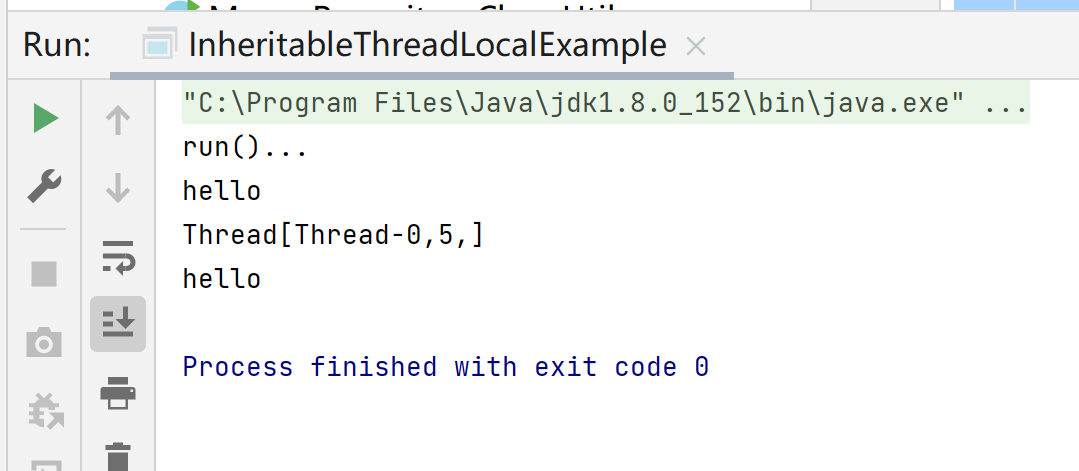一、引出结论
学习过ThreadLocal的童鞋都知道,在子线程中,是无法访问父线程通过ThreadLocal设置的变量的。
package thread;
/**
* @author heyunlin
* @version 1.0
*/
public class ThreadLocalExample {
public static void main(String[] args) throws InterruptedException, NoSuchFieldException, IllegalAccessException {
ThreadLocal<String> threadLocal = new ThreadLocal<>();
threadLocal.set("hello");
Thread thread = new Thread(new Runnable() {
@Override
public void run() {
System.out.println("run()...");
/*
* 子线程中无法访问父线程中设置的ThreadLocal变量
*/
System.out.println(threadLocal.get());
}
});
thread.start();
thread.join();
System.out.println(thread);
System.out.println(threadLocal.get());
}
}运行结果:

InheritableThreadLocal就是为了解决这个不可见问题而生的~
package thread;
/**
* @author heyunlin
* @version 1.0
*/
public class InheritableThreadLocalExample {
public static void main(String[] args) throws InterruptedException, NoSuchFieldException, IllegalAccessException {
InheritableThreadLocal<String> threadLocal = new InheritableThreadLocal<>();
threadLocal.set("hello");
Thread thread = new Thread(new Runnable() {
@Override
public void run() {
System.out.println("run()...");
System.out.println(threadLocal.get());
}
});
thread.start();
thread.join();
System.out.println(thread);
System.out.println(threadLocal.get());
}
}运行结果:

二、分析原因
那么, 究竟是什么原因导致的子线程无法访问父线程中的ThreadLocal变量呢,接下来研究ThreadLocal这个类的源码。
先看一下这个ThreadLocal类上的文档注释,大概了解ThreadLocal是用来干什么的
/**
* This class provides thread-local variables. These variables differ from
* their normal counterparts in that each thread that accesses one (via its
* {@code get} or {@code set} method) has its own, independently initialized
* copy of the variable. {@code ThreadLocal} instances are typically private
* static fields in classes that wish to associate state with a thread (e.g.,
* a user ID or Transaction ID).
*
* <p>For example, the class below generates unique identifiers local to each
* thread.
* A thread's id is assigned the first time it invokes {@code ThreadId.get()}
* and remains unchanged on subsequent calls.
* <pre>
* import java.util.concurrent.atomic.AtomicInteger;
*
* public class ThreadId {
* // Atomic integer containing the next thread ID to be assigned
* private static final AtomicInteger nextId = new AtomicInteger(0);
*
* // Thread local variable containing each thread's ID
* private static final ThreadLocal<Integer> threadId =
* new ThreadLocal<Integer>() {
* @Override protected Integer initialValue() {
* return nextId.getAndIncrement();
* }
* };
*
* // Returns the current thread's unique ID, assigning it if necessary
* public static int get() {
* return threadId.get();
* }
* }
* </pre>
* <p>Each thread holds an implicit reference to its copy of a thread-local
* variable as long as the thread is alive and the {@code ThreadLocal}
* instance is accessible; after a thread goes away, all of its copies of
* thread-local instances are subject to garbage collection (unless other
* references to these copies exist).
*
* @author Josh Bloch and Doug Lea
* @since 1.2
*/
1、关键注释
博主在类的文档注释上提取了几个关于ThreadLocal的重要的说明
This class provides thread-local variables.
这个类提供了线程本地变量
ThreadLocal instances are typically private static fields in classes that wish to associate state with a thread.
ThreadLocal实例提供了可以关联一个线程的静态字段。
Each thread holds an implicit reference to its copy of a thread-local variable as long as the thread is alive and the ThreadLocal instance is accessible; after a thread goes away, all of its copies of thread-local instances are subject to garbage collection (unless other references to these copies exist).
只要线程是存活状态,并且ThreadLocal对象可以访问,每个线程都拥有一个线程本地变量的副本的引用;
在线程执行完方法之后,所有线程本地变量都会被gc(垃圾收集器)回收,除非有其他变量引用了它。
2、研究源码
经过上面博主的大致翻译,已经对ThreadLocal有了一定的了解,接下来深入源码去学习ThreadLocal的工作原理。
在不了解ThreadLocal的情况下,直接从我们直接调用的get()和set()方法入手。
public class ThreadLocal<T> {
public T get() {
Thread thread = Thread.currentThread();
ThreadLocalMap map = getMap(thread);
if (map != null) {
ThreadLocalMap.Entry e = map.getEntry(this);
if (e != null) {
T result = (T)e.value;
return result;
}
}
return setInitialValue();
}
public void set(T value) {
Thread thread = Thread.currentThread();
ThreadLocalMap map = getMap(thread);
if (map != null) {
map.set(this, value);
} else {
createMap(t, value);
}
}
}set()方法
public void set(T value) {
// 获取当前线程
Thread thread = Thread.currentThread();
// 根据当前线程获取ThreadLocalMap对象
ThreadLocalMap map = getMap(thread);
// map不为null,设置初始值到map中
if (map != null) {
map.set(this, value);
} else {
// map是null,创建一个map
createMap(t, value);
}
}getMap()
看样子和线程类Thead里的一个threadLocals变量有关。
ThreadLocal.ThreadLocalMap getMap(Thread thread) {
// 这个方法就是返回Thread的threadLocals变量的值
return thread.threadLocals;
}ThreadLocalMap是ThreadLocal的一个静态内部类
public class ThreadLocal<T> {
static class ThreadLocalMap {
}
}set()
ThreadLocal.ThreadLocalMap的set()方法,有点复杂,类似HashMap的底层源码实现。
private void set(ThreadLocal<?> key, Object value) {
ThreadLocal.ThreadLocalMap.Entry[] tab = table;
int len = tab.length;
int i = key.threadLocalHashCode & (len-1);
for (ThreadLocal.ThreadLocalMap.Entry e = tab[i]; e != null; e = tab[i = nextIndex(i, len)]) {
ThreadLocal<?> k = e.get();
if (k == key) {
e.value = value;
return;
}
if (k == null) {
replaceStaleEntry(key, value, i);
return;
}
}
tab[i] = new ThreadLocal.ThreadLocalMap.Entry(key, value);
int sz = ++size;
if (!cleanSomeSlots(i, sz) && sz >= threshold) {
rehash();
}
}createMap()
void createMap(Thread thread, T firstValue) {
// 初始化线程的threadLocals变量
thread.threadLocals = new ThreadLocal.ThreadLocalMap(this, firstValue);
}set()方法总结
根据set()方法的源代码,set()方法是把值设置到Thead线程类的threadLocals变量中,这个变量应该是一个Map派生类的实例。
get()方法
public T get() {
Thread thread = Thread.currentThread(); // 获取当前线程
// 通过getMap()方法获取一个ThreadLocalMap对象
// 因为这个类是以Map结尾的,推测是java.util.Map的派生类
ThreadLocalMap map = getMap(thread);
// 获取到的map不为null
if (map != null) {
// 获取Map的Entry
// 说明我们的推测大概率是正确的,因为HashMap中也有个Enty,而且也有value()方法
ThreadLocalMap.Entry e = map.getEntry(this);
// 获取的value不为空,则转为指定的类型T(泛型)直接返回
if (e != null) {
T result = (T) e.value;
return result;
}
}
// 代码运行到这里,说明获取到的map是null
// 因为前面的if中已经通过return结束方法
return setInitialValue();
}getMap()
这个方法的代码在前面set()方法里已经看了~
createMap()
这个方法的代码在前面set()方法里已经看了~
setInitialValue()
这个方法和set()方法的代码几乎一模一样。知识多了一个返回值~
T value = initialValue();
set()方法的代码
return value;
private T setInitialValue() {
// 通过initialValue()方法获取一个初始化值
T value = initialValue();
// 获取当前线程
Thread thread = Thread.currentThread();
// 根据当前线程获取ThreadLocalMap对象
ThreadLocalMap map = getMap(thread);
// map不为null,设置初始值到map中
if (map != null) {
map.set(this, value);
} else {
// map是null,创建一个map
createMap(thread, value);
}
// 返回初始值
return value;
}get()方法总结
综合上面关于get()方法的源代码,get()方法是从Thead线程类的threadLocals变量中获取数据。
ThreadLocal.ThreadLocalMap
下面是ThreadLocalMap类的一些关键的代码,很显然,这个内部类的结构设计的和HashMap非常相似,通过一个数组table保存值,根据传入的key进行特定的hash运算得到数组的下标,然后获取对应数组下标的值返回。
public class ThreadLocal<T> {
static class ThreadLocalMap {
static class Entry extends WeakReference<ThreadLocal<?>> {
Object value;
Entry(ThreadLocal<?> k, Object v) {
super(k);
value = v;
}
}
private static final int INITIAL_CAPACITY = 16;
private ThreadLocal.ThreadLocalMap.Entry[] table;
private int size = 0;
private int threshold;
private ThreadLocal.ThreadLocalMap.Entry getEntry(ThreadLocal<?> key) {
int i = key.threadLocalHashCode & (table.length - 1);
ThreadLocal.ThreadLocalMap.Entry e = table[i];
if (e != null && e.get() == key) {
return e;
} else {
return getEntryAfterMiss(key, i, e);
}
}
}
}三、代码总结
文章稍微学习的深入了一点,可能有些童鞋已经懵了,但是回到set()和get()方法的代码可以发现
不管你存储值的代码如何复杂,都是通过当前线程作为key存储在ThreadLocal的静态内部类ThreadLocalMap中的,知道这点其实就够了。
在子线程中,由于通过new Thread()新开了一个线程,那么当代码执行这个新开的子线程的run()方法内部,当前线程已经不是刚开始执行方法的线程了。
比如:在main方法中,执行代码的线程是main线程,也就是主线程,它的线程名就是main。
但是新开一个线程,它的线程名是通过Threa-0开始编号的
通过一个简单的代码了解一下
/**
* @author heyunlin
* @version 1.0
*/
public class Example {
public static void main(String[] args) {
System.out.println(Thread.currentThread());
new Thread() {
@Override
public void run() {
System.out.println(Thread.currentThread());
}
}.start();
}
}运行结果:

也就是说,在不同线程中,当前线程已经发生了改变,调用ThreaLocal的get()方法的key变了,自然获取不到我们当初设置的变量值。
好了,文章就分享到这里了,看完不要忘了点赞+收藏哦~





















 1418
1418











 被折叠的 条评论
为什么被折叠?
被折叠的 条评论
为什么被折叠?








